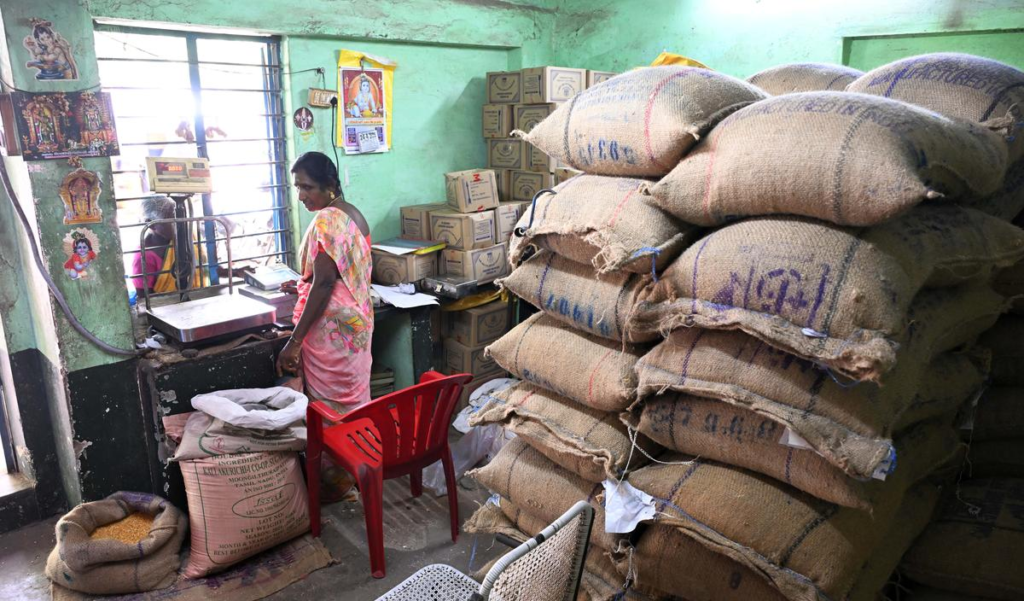| UPSC RELEVANCE- Prelims Pointers-ONORC,PM POSHAN Yojana,ICDS,AgriStack, e-NAM,SOFI Report MAINS- GS Paper II – Governance & Social Justice Public Distribution System reforms Welfare schemes (ICDS, PM POSHAN) Digital governance in food security GS Paper III – Agriculture & Economy Agrifood system reforms Cold chain and food processing infrastructure Role of FPOs and cooperatives |
Why in News
The UN’s State of Food Security and Nutrition in the World 2025 (SOFI Report) shows that global undernourishment fell from 688 million in 2023 to 673 million in 2024 (8.2% of the global population). India has played a central role in this progress, with 30 million fewer undernourished people between 2020–22 and 2022–24, thanks to reforms in food security and nutrition delivery.

Background
Hunger surged during the COVID-19 pandemic, reversing decades of gains. India, home to 1.4 billion people, faced food supply disruptions and rising prices. Yet, through a revamped Public Distribution System (PDS) and targeted nutrition schemes, it stabilised food access for 800+ million beneficiaries.
However, while hunger has declined, nutrition challenges remain:
- High cost of healthy diets (unaffordable for 60% of Indians).
- Persistent child malnutrition and micronutrient deficiencies.
- Rising obesity and diet-related diseases among the poor.
Thus, the challenge has shifted from food security to nutrition security.
Transformation of the PDS
India’s PDS has undergone a digital revolution:
- Aadhaar-enabled targeting, biometric authentication, real-time inventory tracking reduced leakages.
- One Nation, One Ration Card (ONORC) enabled portability for migrants.
- Pandemic response: Rapid scale-up ensured uninterrupted access to staples for millions.
👉 This made PDS not just a safety net, but a resilient lifeline.
Key Issues and Challenges
- Affordability of Healthy Diets
○ Nutrient-rich foods remain expensive; over 60% cannot afford balanced diets. - Nutrition Gap
○ Schemes like PM POSHAN (2021) and ICDS are integrating dietary diversity, but coverage remains patchy. - Food Losses & Infrastructure Gaps
○ About 13% of food is lost post-harvest due to inadequate cold chains, logistics, and storage. - Double Burden of Malnutrition
○ Coexistence of undernutrition, obesity, and micronutrient deficiencies, particularly in urban poor populations
Dimensions of Agrifood System Transformation
- Diversification of Production: Incentivise pulses, fruits, vegetables, and climate-resilient crops alongside rice and wheat.
- Post-Harvest Investments: Expand cold storage, food processing, and digital logistics.
- Community Enterprises: Empower FPOs and women-led cooperatives to strengthen both livelihoods and nutrition outcomes.
- Digital Agriculture: Scale up AgriStack, e-NAM, and geospatial data tools for market linkages and data-driven policy.
- Global Leadership: Share India’s experience in digital governance, PDS reforms, and social protection with the Global South.
Way Forward
- Shift from Calories to Nutrition – Make nutrition-sensitive food (pulses, fruits, vegetables, fortified foods) central to PDS and welfare schemes.
- Ensure Affordability of Diets – Subsidise nutrient-dense foods and strengthen supply chains.
- Scale Up Nutrition Schemes – Strengthen ICDS and PM POSHAN to improve child and maternal health outcomes.
- Reduce Food Waste – Modernise logistics and expand cold storage to cut post-harvest losses.
- Leverage India’s Digital Edge – Use big data and tech platforms for planning, monitoring, and transparent delivery.
Conclusion
India has shown that hunger can be tackled through political will, digital innovation, and inclusive governance. Pulling 30 million people out of undernourishment in just two years is no small feat. But with five years left for the 2030 SDGs, the real challenge lies in moving from feeding people to nourishing people.
India’s journey from food sufficiency to nutrition adequacy will not only secure its own population but also shape the global fight against hunger. Truly, the road to ending global hunger runs through India.
UPSC Prelims Practice Question
Q. With reference to the State of Food Security and Nutrition in the World (SOFI) Report 2025, consider the following statements:
- The proportion of undernourished population in India has declined in recent years.
- More than half of India’s population cannot afford a healthy diet, which is higher than the global average.
- India’s digital innovations such as ONORC and e-NAM have been highlighted globally as models for improving food security.
Which of the statements given above is/are correct?
A. 1 only
B. 1 and 2 only
C. 2 and 3 only
D. 1, 2 and 3
| Answer: D (1, 2 and 3) Statement 1 – Correct: Undernourishment in India has declined from 14.3% (2020–22) to 12% (2022–24). Statement 2 – Correct: Over 60% of Indians cannot afford a healthy diet vs ~42% global average. Statement 3 – Correct: ONORC, Digital PDS, and e-NAM have been highlighted in global reports as innovative governance models. |
Mains practice Questions
- “India’s fight against hunger has shifted from food security to nutrition security.” Discuss.
- Examine the role of digitalisation in transforming India’s Public Distribution System.
- How can India’s agrifood system transformation contribute to achieving SDG 2 (Zero Hunger)?
SOURCE- THE HINDU
Found this helpful? Bookmark for revision, Practice the mains question, and Share with fellow aspirants! THANK YOU
